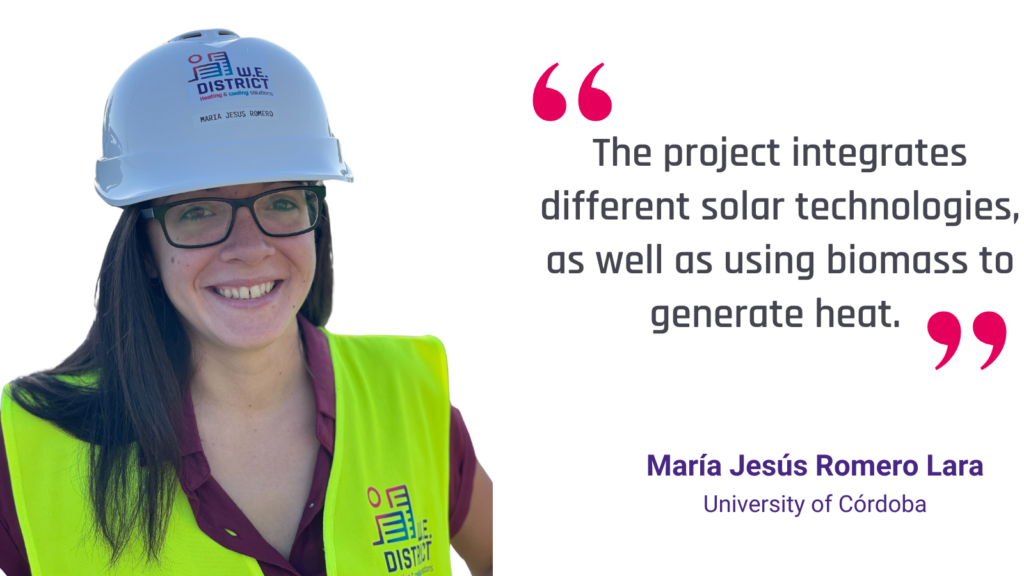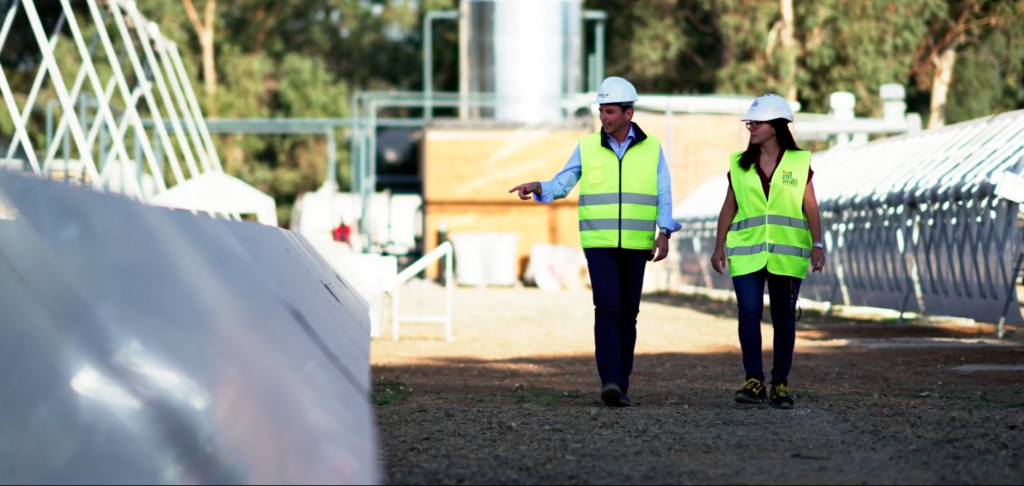
María Jesús Romero-Lara is a PhD student at the University of Córdoba, Spain, focusing on advanced computing, energy, and plasmas. Romero-Lara also holds a Master of Science in Industrial Engineering and a degree in Mechanical Engineering. She is actively engaged in the European research project W.E.District. She is contributing her expertise to innovative solutions in these critical areas at the demosite in Córdoba. Her research reflects a deep commitment to advancing technology and knowledge in energy systems and computational techniques.
ESCI: You are an industrial and mechanical engineer by training.
What was your first impression when you heard about this project?
Mariá Jesús Romero-Lara: Initially, I couldn’t imagine the variety of technologies that would come together in this project. We are integrating three different solar technologies—parabolic trough, linear Fresnel, and flat-plate collectors —alongside biomass to generate heat. We also introduced cooling systems, like the absorption chiller and the “Renewable Air Cooling Unit”(RACU), which is a prototype developed by our research group. The combination of these elements makes this project very exciting.
ESCI: Speaking of technology integration, what do you think was the most challenging part of this project?
Mariá Jesús Romero-Lara: From my point of view, the main challenge was the step-by-step integration of different technologies—both solar and biomass systems—and ensuring that they all functioned together smoothly. For instance, solar technologies usually operate at lower temperatures, which isn’t typical in most district heating systems. Additionally, ensuring that our cooling units, such as the absorption chiller and the RACU, work with the available heat and under optimal conditions, required careful design and real-time problem-solving during the installation process.
ESCI: Can you tell us more about the RACU prototype? What makes it innovative?
Mariá Jesús Romero-Lara: The RACU is a renewable air-cooling unit that integrates two technologies to manage both temperature and humidity. It includes an dew-point indirect evaporative cooler, which helps control the supply air temperature and indoor air quality. The second component is a desiccant wheel that regulates humidity by treating 100% fresh outdoor air—unlike conventional systems, which recirculate the indoor air. This makes the RACU more sustainable, with lower energy consumption and reduced environmental impact, while maintaining thermal comfort and high air quality inside the building.
ESCI: Biomass boilers also play a crucial role in the sustainability and efficiency of energy systems. What specific advantages do the biomass boilers of the demosite in Córdoba offer?
Mariá Jesús Romero-Lara: The biomass boilers in this project are designed to be poly-fuel systems, meaning they can utilize various types of biomasses. Specifically, we use almond shells, olive pits, wood chips, and pellets. For the Córdoba demonstration, we will be using wood chips for combustion and other tasks to generate hot water for the district network. Each boiler has a capacity of 500 kilowatts and is equipped with electrostatic precipitators to minimize emissions effectively.

ESCI: What has been the most surprising or unexpected aspect of working on this project?
Mará Jesús Romero-Lara: Surprisingly, it wasn’t just the scientific tasks that posed challenges, but also administrative issues. We had to develop and learn administrative tasks to be able to launch, for example, the bidding process.This versatility–economical, technical and scientifical tasks -was something I didn’t expect when I first joined the project.
ESCI: What are your key goals for the future once the demo site becomes fully operational, and how do you envision its impact on the local community?
Mará Jesús Romero-Lara: One of our primary objectives is to cover the heating and cooling demands of the Leonardo Da Vinci buildings and the Monte Cronos sports stadium using 100% renewable energy. Our aim is to generate 1.5 megawatts of thermal energy through a combination of solar and biomass technologies. For cooling, we plan to utilize a 413-kilowatt absorption chiller along with the RACU prototype, which will allow us to meet almost all of the cooling demands. Achieving these milestones will bring us closer to realizing the vision of a fully renewable district energy network.
ESCI: Thank you for this interview, María Jesús.